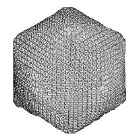Plant Pathology, Department of

James Van Etten Publications
Document Type
Article
Date of this Version
2007
Citation
Published in final edited form as: Virology. 2007 June 5; 362(2): 350–361.
- PMID:
- 17276475
- PMCID:
- PMC2018652
Abstract
Acanthocystis turfacea chlorella virus (ATCV-1), a prospective member of the family Phycodnaviridae, genus Chlorovirus, infects a unicellular, eukaryotic, chlorella-like green alga, Chlorella SAG 3.83, that is a symbiont in the heliozoon A. turfacea. The 288,047-bp ATCV-1 genome is the first virus to be sequenced that infects Chlorella SAG 3.83. ATCV-1 contains 329 putative protein-encoding and 11 tRNA-encoding genes. The protein-encoding genes are almost evenly distributed on both strands and intergenic space is minimal. Thirty-four percent of the viral gene products resemble entries in the public databases, including some that are unexpected for a virus. For example, these unique gene products include ribonucleoside-triphosphate reductase, dTDP-D-glucose 4,6 dehydratase, potassium ion transporter, aquaglyceroporin, and mucindesulfating sulfatase. Comparison of ATCV-1 protein-encoding genes with the prototype chlorella virus PBCV-1 indicates that about 80% of the ATCV-1 genes are present in PBCV-1.


Comments
Published by Elsevier. Used by permission.